Breast Organ Dose and Radiation Exposure Reduction in Full-Spine Radiography: A Phantom Model Using PCXMC
Abstract
1. Introduction
2. Materials and Methods
2.1. PCXMC-Monte Carlo Program
2.2. Calculation of Organ Dose to the Breast Using Full-Spine Imaging
2.3. Relationship Among Breast Organ Dose, Standard Error, and Calculation Time Based on Changes in the Number of Photon History Sets
- : all data points;
- i: predicted value;
- : true value.
3. Results
3.1. Calculation of Organ Dose to the Breast from Full-Spine Imaging
3.2. Estimated Organ Dose to the Breast, Standard Error, and Calculation Time Based on Changes in the Number of Photon Sets
4. Discussion
4.1. Estimated Organ Dose to the Breast from Full-Spine Radiography
4.2. Estimated Organ Dose, Standard Error, and Computation Time for the Breast with Variations in NPhots
4.3. Limitations
5. Conclusions
Author Contributions
Funding
Institutional Review Board Statement
Informed Consent Statement
Data Availability Statement
Acknowledgments
Conflicts of Interest
Abbreviations
| NPhots | number of photon histories per radiation field |
| AP | anteroposterior |
| PA | posteroanterior |
| FID | focus-image receptor distance |
| MAPE | mean absolute percentage error |
References
- International Commission on Radiological Protection. The 2007 Recommendations of the International Commission on Radiological Protection; ICRP Publication 103; ICRP: Stockholm, Sweden, 2007; Volume 37, pp. 1–339. [Google Scholar]
- Chida, K. What Are Useful Methods to Reduce Occupational Radiation Exposure among Radiological Medical Workers, Especially for Interventional Radiology Personnel? Radiol. Phys. Technol. 2022, 15, 101–115. [Google Scholar] [CrossRef]
- Sagehashi, K.; Haga, Y.; Takahira, S.; Tanabe, M.; Nakamura, M.; Sota, M.; Kaga, Y.; Abe, M.; Tada, N.; Chida, K. Evaluation of Radiation Dose to the Lens in Interventional Cardiology Physicians before and after Dose Limit Regulation Changes. J. Radiol. Prot. 2024, 44, 031512. [Google Scholar] [CrossRef] [PubMed]
- International Commission on Radiological Protection (ICRP). Avoidance of Radiation Injuries from Medical Interventional Procedures. ICRP Publication 85. Ann. ICRP 2000, 30, 7. [Google Scholar] [CrossRef]
- Kato, M.; Chida, K.; Sato, T.; Oosaka, H.; Tosa, T.; Munehisa, M.; Kadowaki, K. The necessity of follow-up for radiation skin injuries in patients after percutaneous coronary interventions: Radiation skin injuries will often be overlooked clinically. Acta Radiol. 2012, 53, 1040–1044. [Google Scholar] [CrossRef] [PubMed]
- Muhammad, N.A.; Abdul Karim, M.K.; Abu Hassan, H.; Ahmad Kamarudin, M.; Ding Wong, J.H.; Ng, K.H. Diagnostic reference level of radiation dose and image quality among paediatric CT examinations in A Tertiary Hospital in Malaysia. Diagnostics 2020, 10, 591. [Google Scholar] [CrossRef]
- International Commission on Radiological Protection (ICRP). ICRP Statement on Tissue Reactions and Early and Late Effects of Radiation in Normal Tissues and Organs–Threshold Doses for Tissue Reactions in a Radiation Protection Context. ICRP Publication 118. Ann. ICRP 2012, 41, 1–322. [Google Scholar] [CrossRef] [PubMed]
- Chida, K.; Saito, H.; Otani, H.; Kohzuki, M.; Takahashi, S.; Yamada, S.; Shirato, K.; Zuguchi, M. Relationship between fluoroscopic time, dose-area product, body weight, and maximum radiation skin dose in cardiac interventional procedure. AJR Am. J. Roentgenol. 2006, 186, 774–778. [Google Scholar] [CrossRef]
- Yamada, A.; Haga, Y.; Sota, M.; Abe, M.; Kaga, Y.; Inaba, Y.; Suzuki, M.; Tada, N.; Zuguchi, M.; Chida, K. Eye Lens Radiation Dose to Nurses during Cardiac Interventional Radiology: An Initial Study. Diagnostics 2023, 13, 3003. [Google Scholar] [CrossRef]
- Fujisawa, M.; Haga, Y.; Sota, M.; Abe, M.; Kaga, Y.; Inaba, Y.; Suzuki, M.; Meguro, T.; Hosoi, Y.; Chida, K. Evaluation of Lens Doses among Medical Staff Involved in Nuclear Medicine: Current Eye Radiation Exposure among Nuclear-Medicine Staff. Appl. Sci. 2023, 13, 9182. [Google Scholar] [CrossRef]
- Ohno, S.; Konta, S.; Shindo, R.; Yamamoto, K.; Isobe, R.; Inaba, Y.; Suzuki, M.; Zuguchi, M.; Chida, K. Effect of backscatter radiation on the occupational eye-lens dose. J. Radiat. Res. 2024, 65, 450–458. [Google Scholar] [CrossRef]
- Weinstein, S.L.; Dolan, L.A.; Cheng, J.C.; Danielsson, A.; Morcuende, J.A. Adolescent idiopathic scoliosis. Lancet 2008, 371, 1527–1537. [Google Scholar] [CrossRef]
- Cheng, J.C.; Castelein, R.M.; Chu, W.C.; Danielsson, A.J.; Dobbs, M.B.; Grivas, T.B.; Gurnett, C.A.; Luk, K.D.; Moreau, A.; Newton, P.O.; et al. Adolescent idiopathic scoliosis. Nat. Rev. Dis. Primers 2015, 1, 15030. [Google Scholar] [CrossRef]
- Altaf, F.; Gibson, A.; Dannawi, Z.; Noordeen, H. Adolescent idiopathic scoliosis. BMJ 2013, 346, f2508. [Google Scholar] [CrossRef] [PubMed]
- Simony, A.; Hansen, E.J.; Christensen, S.B.; Carreon, L.Y.; Andersen, M.O. Incidence of cancer in adolescent idiopathic scoliosis patients treated 25 years previously. Eur. Spine J. 2016, 25, 3366–3370. [Google Scholar] [CrossRef]
- Sugawara, R.; Watanabe, H.; Taki, N.; Onuma, S.; Kikkawa, I.; Takeshita, K. Radiation exposure in pediatric patients with early onset scoliosis: A longitudinal single-center study. J. Orthop. Sci. 2024, 29, 1103–1107. [Google Scholar] [CrossRef] [PubMed]
- Ul Haque, M.; Shufflebarger, H.L.; O’Brien, M.; Macagno, A. Radiation exposure during pedicle screw placement in adolescent idiopathic scoliosis: Is fluoroscopy safe? Spine 2006, 31, 2516. [Google Scholar] [CrossRef] [PubMed]
- Ronckers, C.M.; Land, C.E.; Miller, J.S.; Stovall, M.; Lonstein, J.E.; Doody, M.M. Cancer mortality among women frequently exposed to radiographic examinations for spinal disorders. Radiat. Res. 2010, 174, 83–90. [Google Scholar] [CrossRef]
- Berlin, C.; Quante, M.; Thomsen, B.; Koeszegvary, M.; Platz, U.; Ivanits, D.; Halm, H. Intraoperative radiation exposure to patients in idiopathic scoliosis surgery with freehand insertion technique of pedicle screws and comparison to navigation techniques. Eur. Spine J. 2020, 29, 2036–2045. [Google Scholar] [CrossRef]
- Jones, J.Y.; Saigal, G.; Palasis, S.; Booth, T.N.; Hayes, L.L.; Iyer, R.S.; Kadom, N.; Kulkarni, A.V.; Milla, S.S.; Myseros, J.S.; et al. ACR Appropriateness Criteria Scoliosis-Child. J. Am. Coll. Radiol. 2019, 16, S244–S251. [Google Scholar] [CrossRef]
- Doody, M.M.; Lonstein, J.E.; Stovall, M.; Hacker, D.G.; Luckyanov, N.; Land, C.E. Breast cancer mortality after diagnostic radiography: Findings from the U.S. scoliosis cohort study. Spine 2000, 25, 2052–2063. [Google Scholar] [CrossRef]
- Hoffman, D.A.; Lonstein, J.E.; Morin, M.M.; Visscher, W.; Harris, B.S.; Boice, J.D. Breast cancer in women with scoliosis exposed to multiple diagnostic x rays. J. Natl. Cancer Inst. 1989, 81, 1307–1312. [Google Scholar] [CrossRef]
- Bone, C.M.; Hsieh, G.H. The risk of carcinogenesis from radiographs to pediatric orthopaedic patients. J. Pediatr. Orthop. 2000, 20, 251–254. [Google Scholar] [CrossRef]
- Levy, A.R.; Goldberg, M.S.; Mayo, N.E.; Hanley, J.A.; Poitras, B. Reducing the lifetime risk of cancer from spinal radiographs among people with adolescent idiopathic scoliosis. Spine 1996, 21, 1540–1547; discussion 1548. [Google Scholar] [CrossRef]
- United Nations Scientific Committee on the Effects of Atomic Radiation (UNSCEAR), Epidemiological Studies of Radiation and Cancer UNSCEAR 2006 Report (Scientific Annex A) vol I (New York: United Nations). 2008. Available online: https://www.unscear.org/unscear/en/publications/2006_1.html (accessed on 7 July 2025).
- Chida, K.; Kato, M.; Kagaya, Y.; Zuguchi, M.; Saito, H.; Ishibashi, T.; Takahashi, S.; Yamada, S.; Takai, Y. Radiation dose and radiation protection for patients and physicians during interventional procedure. J. Radiat. Res. 2010, 51, 97–105. [Google Scholar] [CrossRef]
- Bacher, K.; Bogaert, E.; Lapere, R.; De Wolf, D.; Thierens, H. Patient-specific dose and radiation risk estimation in pediatric cardiac catheterization. Circulation 2005, 111, 83–89. [Google Scholar] [CrossRef]
- Ideguchi, R.; Yoshida, K.; Ohtsuru, A.; Takamura, N.; Tsuchida, T.; Kimura, H.; Uetani, M.; Kudo, T. The present state of radiation exposure from pediatric CT examinations in Japan-what do we have to do? J. Radiat. Res. 2018, 59, ii130–ii136. [Google Scholar] [CrossRef] [PubMed]
- Chida, K.; Ohno, T.; Kakizaki, S.; Takegawa, M.; Yuuki, H.; Nakada, M.; Takahashi, S.; Zuguchi, M. Radiation dose to the pediatric cardiac catheterization and intervention patient. AJR Am. J. Roentgenol. 2010, 195, 1175–1179. [Google Scholar] [CrossRef]
- International Commission on Radiological Protection (ICRP). Conversion Coefficients for Radiological Protection Quantities for External Radiation Exposures. ICRP Publication 116. Ann. ICRP 2010, 40, 1–257. [Google Scholar] [CrossRef] [PubMed]
- Almén, A.J.; Mattsson, S. Dose distribution at radiographic examination of the spine in pediatric radiology. Spine 1996, 21, 750–756. [Google Scholar] [CrossRef]
- Hallen, S.; Martling, K.; Mattsson, S. Dosimetry at X ray examination of scoliosis. Radiat. Prot. Dosim. 1992, 43, 49–54. [Google Scholar] [CrossRef]
- Ruiz, M.J.; González, L.; Vañó, E.; Martínez, A. Measurement of radiation doses in the most frequent simple examinations in paediatric radiology and its dependence on patient age. Br. J. Radiol. 1991, 64, 929–933. [Google Scholar] [CrossRef]
- Gallini, R.E.; Belletti, S.; Berna, V.; Giugni, U. Adult and child doses in standardised X ray examinations. Radiat. Prot. Dosim. 1992, 43, 41–47. [Google Scholar] [CrossRef]
- Gogos, K.A.; Yakoumakis, E.N.; Tsalafoutas, I.A.; Makri, T.K. Radiation dose considerations in common paediatric x-ray examinations. Pediatr. Radiol. 2003, 33, 236–240. [Google Scholar] [CrossRef]
- Hansen, J.; Jurik, A.G.; Fiirgaard, B.; Egund, N. Optimisation of scoliosis examinations in children. Pediatr. Radiol. 2003, 33, 752–765. [Google Scholar] [CrossRef] [PubMed]
- Japan Network for Research and Information on Medical Exposure (J-RIME). National Diagnostic Reference Levels in Japan (2025)-Japan DRLs 2025. 2025. Available online: https://j-rime.qst.go.jp/report/JapanDRLs2025_en.pdf (accessed on 10 October 2025).
- Deschênes, S.; Charron, G.; Beaudoin, G.; Labelle, H.; Dubois, J.; Miron, M.C.; Parent, S. Reducing patients radiation dose with a new slot-scanning X-ray Imager. Spine 2010, 35, 989–994. [Google Scholar] [CrossRef]
- Cool, J.; Streekstra, G.J.; Van Schuppen, J.; Stadhouder, A.; Van den Noort, J.C.; Van Royen, B.J. Estimated cumulative radiation exposure in patients treated for adolescent idiopathic scoliosis. Eur. Spine J. 2023, 32, 1777–1786. [Google Scholar] [CrossRef] [PubMed]
- Noto, Y.; Endo, Y.; Ohashi, M.; Hirano, T.; Chida, K.; Watanabe, K. Usefulness of the spectral shaping dual-source computed tomography imaging technique in posterior corrective fusion for adolescent idiopathic scoliosis. Eur. Spine J. 2024, 33, 706–712. [Google Scholar] [CrossRef] [PubMed]
- Noto, Y.; Kuramoto, T.; Watanabe, K.; Chida, K. Reducing Radiation Dose in Computed Tomography Imaging of Adolescent Idiopathic Scoliosis Using Spectral Shaping Technique with Tin Filter. Tomography 2025, 11, 110. [Google Scholar] [CrossRef]
- Nemoto, M.; Chida, K. Reducing the breast cancer risk and radiation dose of radiography for scoliosis in children: A phantom study. Diagnostics 2020, 10, 753. [Google Scholar] [CrossRef]
- Sweezy, J.E. MCNP—A General Monte Carlo N-Particle Transport Code, version 5; LA-UR-03-1987; Los Alamos National Laboratory: Los Alamos, NM, USA, 2003. [Google Scholar]
- Hirayama, H.; Namito, Y.; Bielajew, A.F.; Wilderman, S.J. The EGS5 Code System; SLAC-730; Stanford Linear Accelerator, Stanford University: Stanford, CA, USA, 2008; Available online: https://www.researchgate.net/publication/255277661_The_EGS5_code_system (accessed on 17 September 2025).
- Agostinelli, S.; Allison, J.; Amako, K.; Apostolakis, J.; Araujo, H.; Arce, P.; Asai, M.; Axen, D.; Banerjee, S.; Barrand, G.; et al. Geant4—A simulation toolkit. Nucl. Instrum. Methods Phys. Res. A 2003, 506, 250–303. [Google Scholar] [CrossRef]
- Borrego, D.; Lowe, E.M.; Kitahara, C.M.; Lee, C. Assessment of PCXMC for patients with different body size in chest and abdominal X ray examinations: A Monte Carlo simulation study. Phys. Med. Biol. 2018, 63, 065015. [Google Scholar] [CrossRef]
- Gialousis, G.; Yiakoumakis, E.N.; Makri, T.K.; Papadoupoulou, D.; Karlatira, M.; Karaiskos, P.; Papaodysseas, S.; Evlogias, N.; Dimitriou, P.A.; Georgiou, E.K. Comparison of dose from radiological examination for scoliosis in children among two pediatric hospitals by Monte Carlo simulation. Health Phys. 2008, 94, 471–478. [Google Scholar] [CrossRef]
- Cristy, M. Mathematical Phantoms Representing Children of Various Ages for Use in Estimates of Internal Dose. NUREG/CR-1159; ORNL/NUREG/TM-367; ON: TI86000170. Available online: https://www.osti.gov/servlets/purl/5308345/ (accessed on 6 May 2019).
- Zankl, M. Adult male and female reference computational phantoms (ICRP Publication 110). Jpn. J. Health Phys. 2010, 45, 357–369. [Google Scholar] [CrossRef]
- Tapiovaara, M. PCXMC 2.0 Supplementary Programs User’s Guide: STUK—Radiation and Nuclear Safety Authority. 2012. Available online: https://stuk.fi/en/pcxmc-monte-carlo-program-for-calculating-patient-doses-from-x-ray-examinations (accessed on 25 August 2025).
- Seidenbusch, M.; Schneider, K. Conversion coefficients for determining organ doses in paediatric spine radiography. Pediatr. Rad. 2014, 44, 434–456. [Google Scholar] [CrossRef]
- Birch, R.; Marshall, M. Computation of bremsstrahlung X-ray spectra and comparison with spectra measured with a Ge(Li) detector. Phys. Med. Biol. 1979, 24, 505–517. [Google Scholar] [CrossRef]
- Siddique, A.H.; Ge, G.; Zhang, J. Comparative evaluation of image quality between virtual grid and grid portable radiographic systems. Biomed. Phys. Eng. Express. 2024, 10, 057004. [Google Scholar] [CrossRef]
- Curran, B.H.; Blater, J.M.; Chetty, I.J. Integrating New Technologies into the Clinic: Monte Carlo and Image-Guided Radiation Therapy; Medical Physics Publishing: Madison, WI, USA, 2006. [Google Scholar]
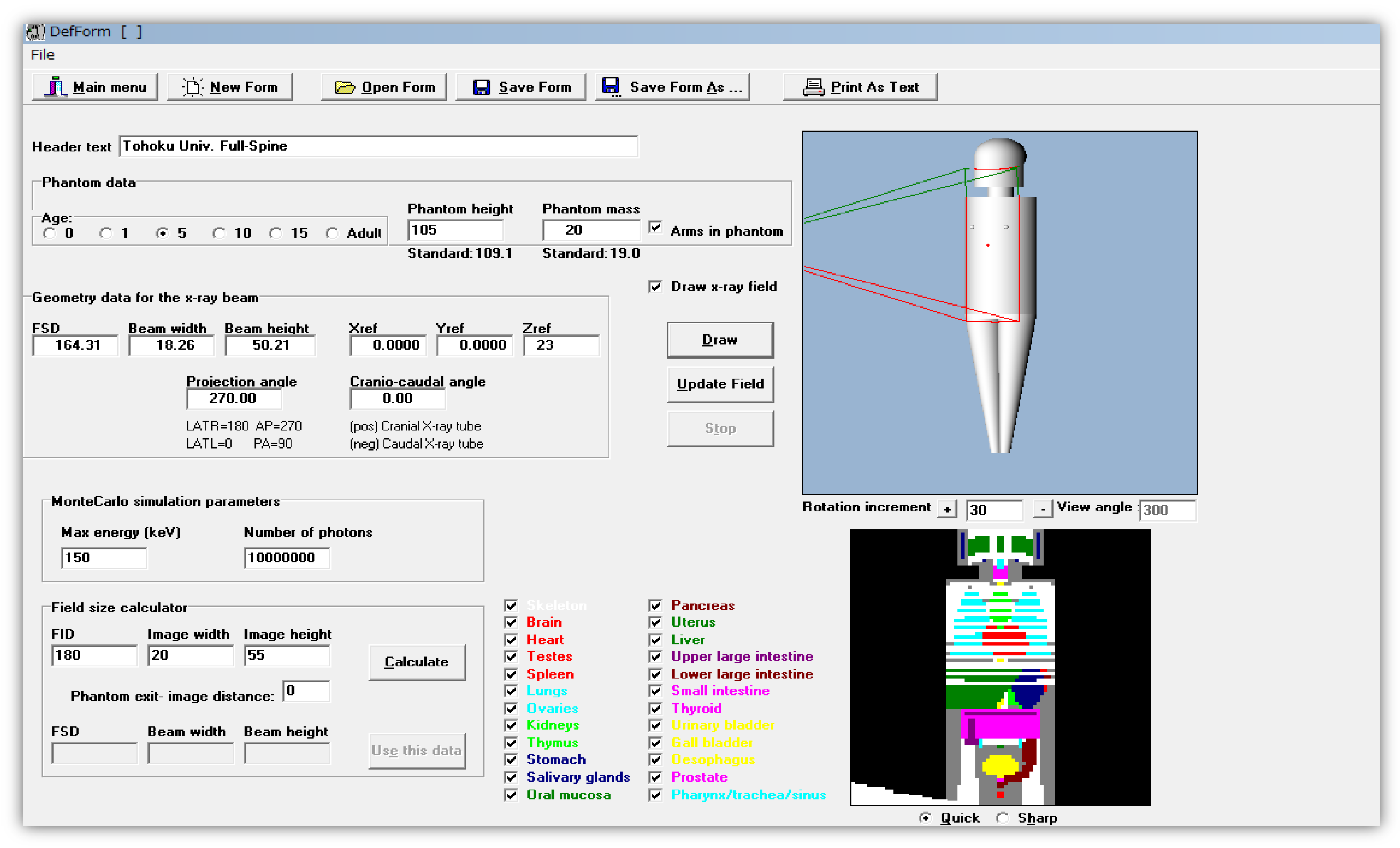

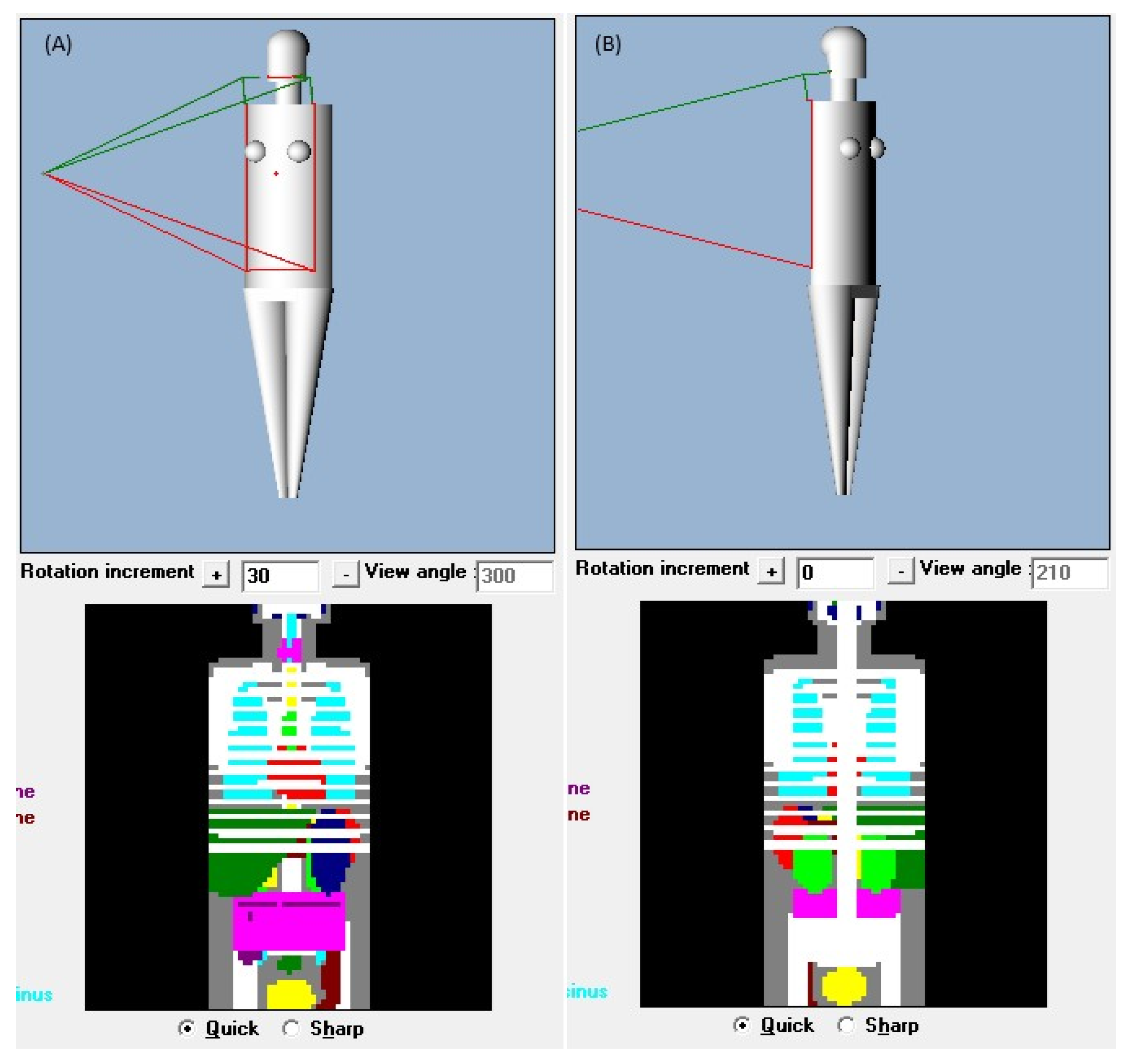
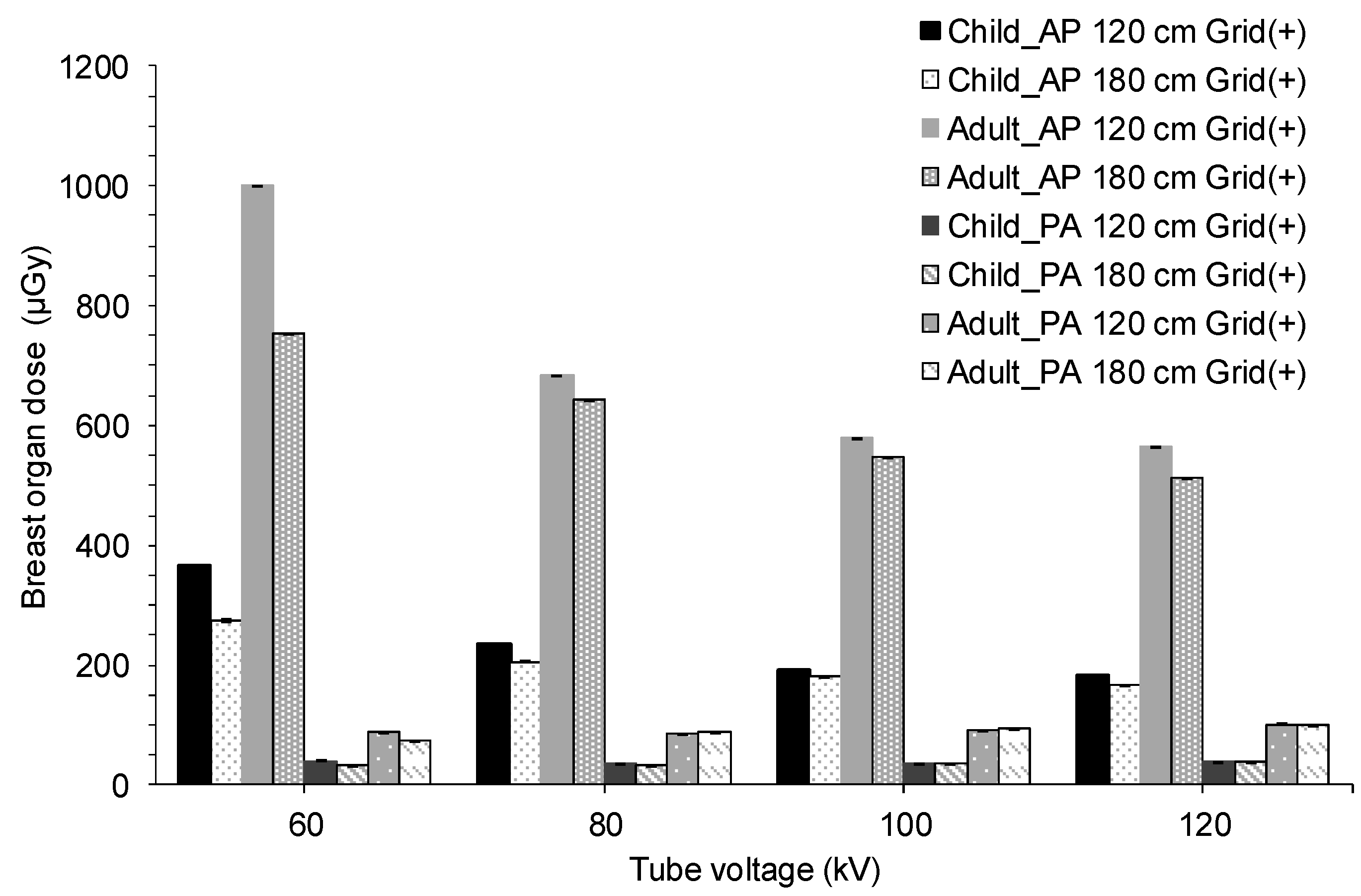
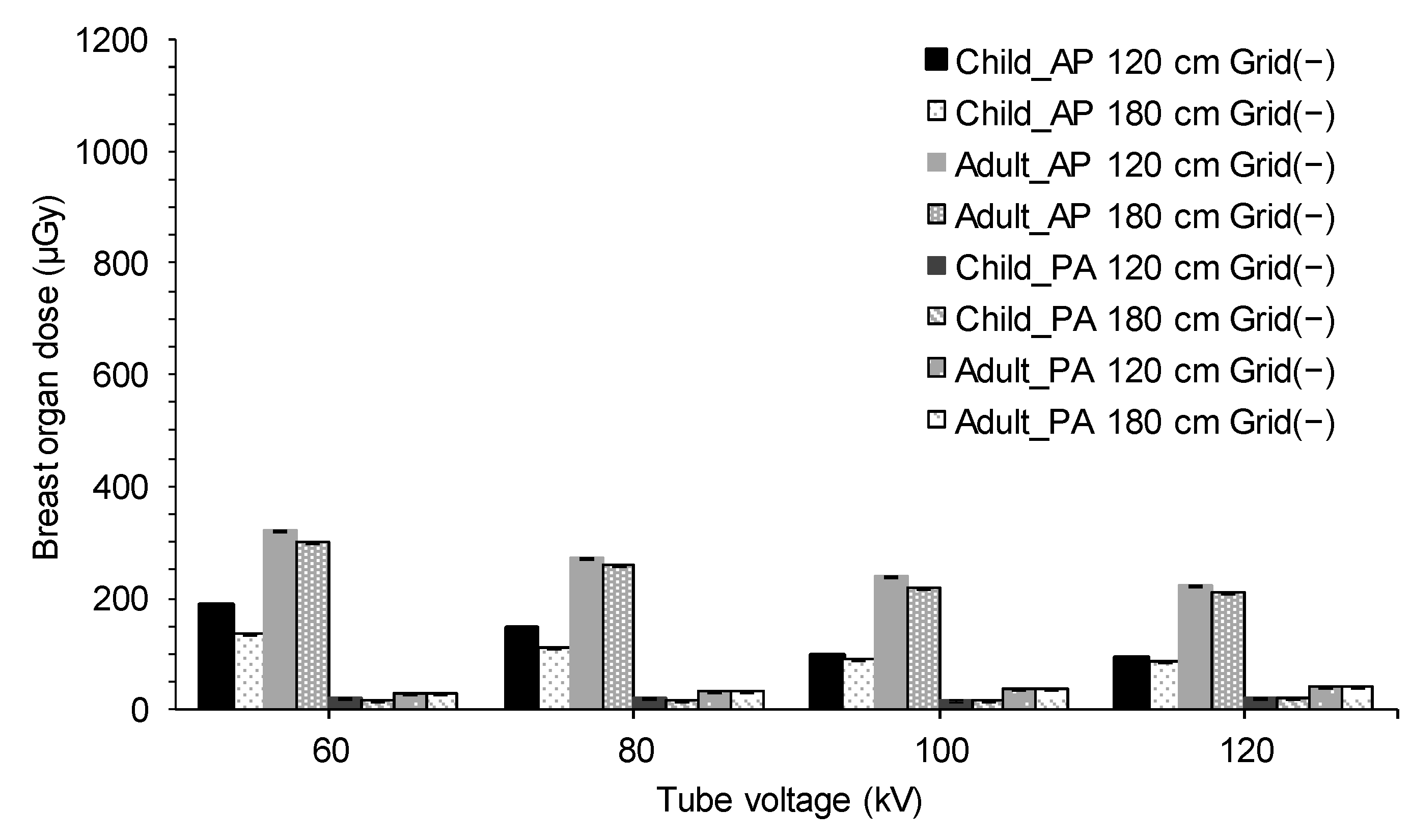
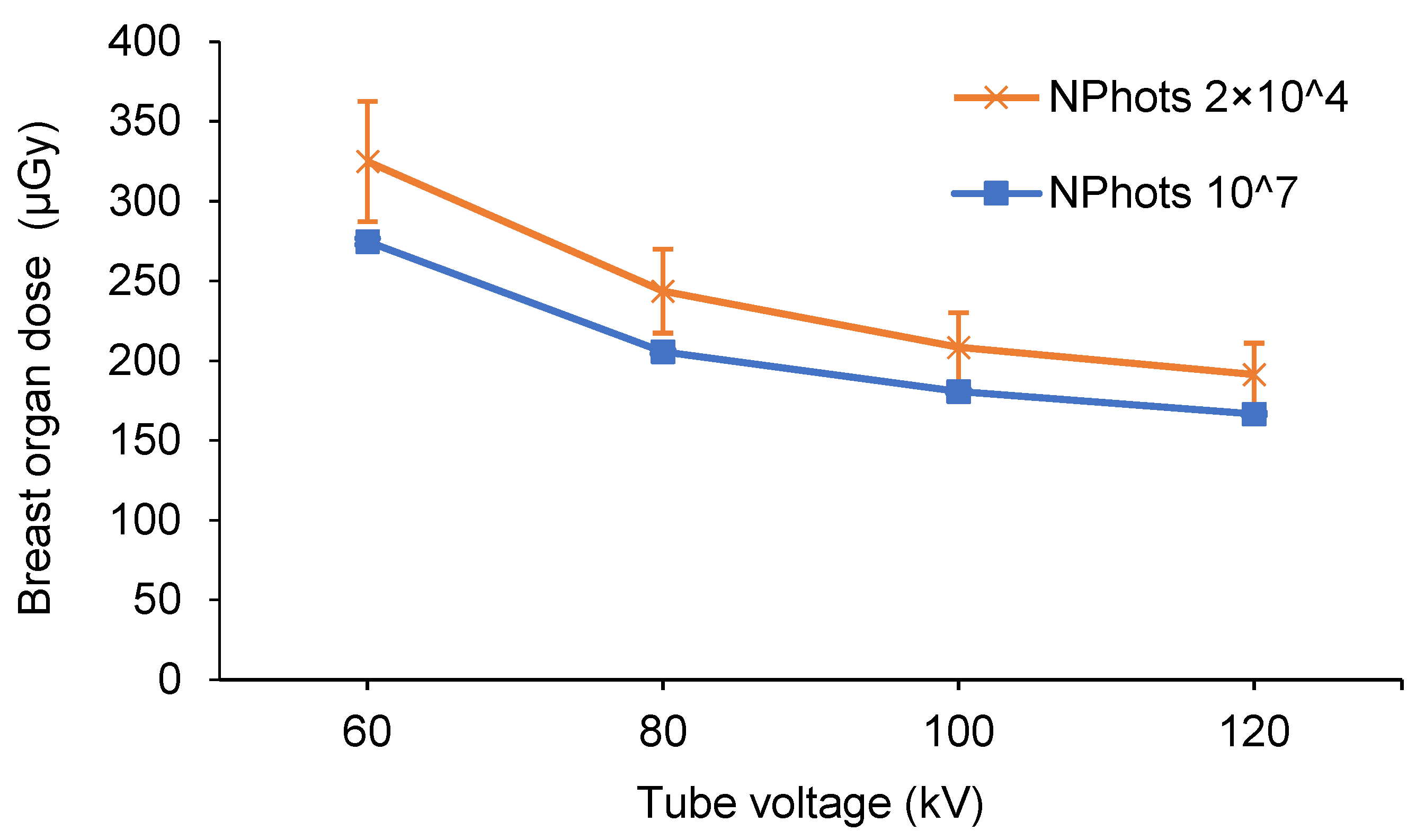
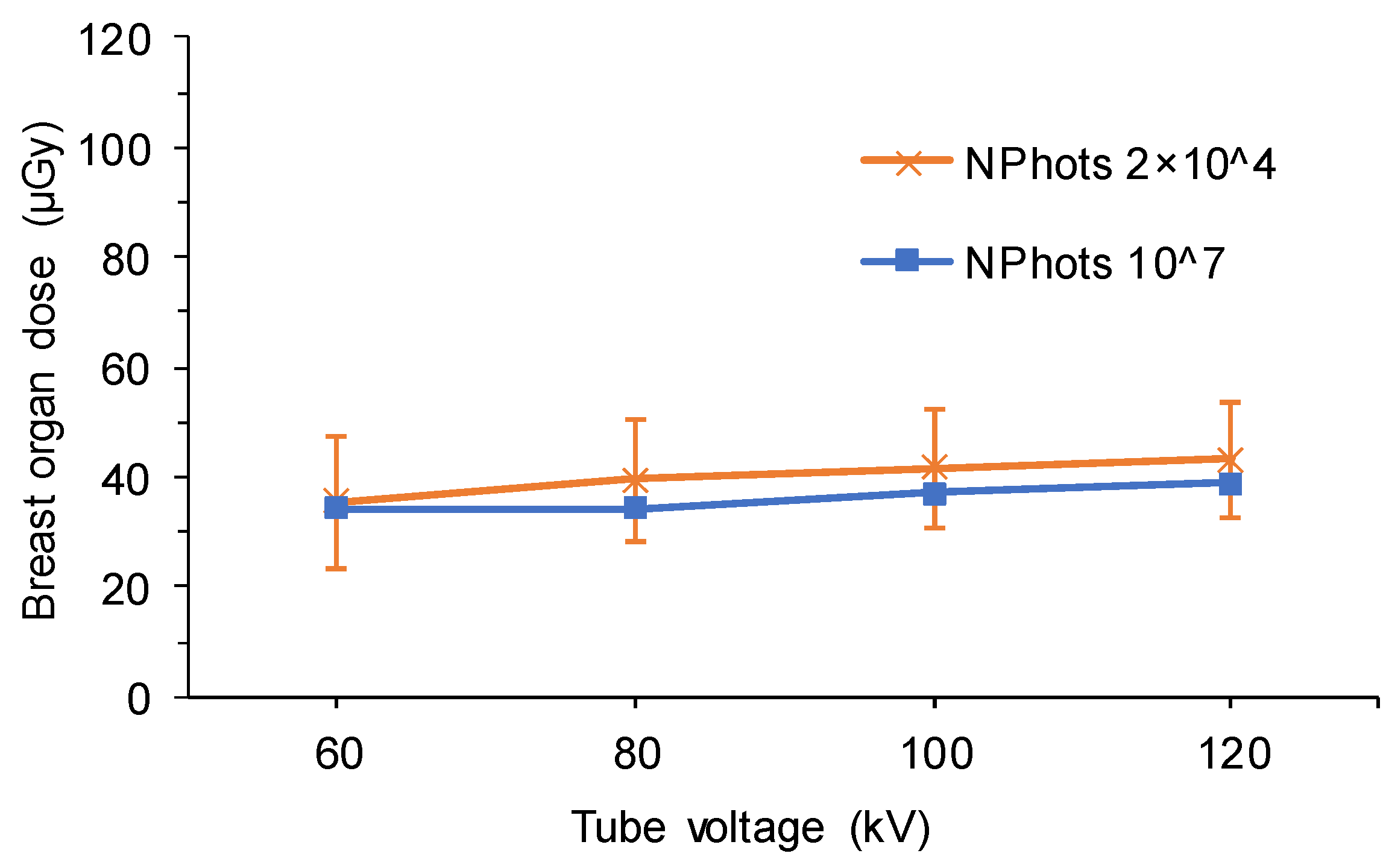

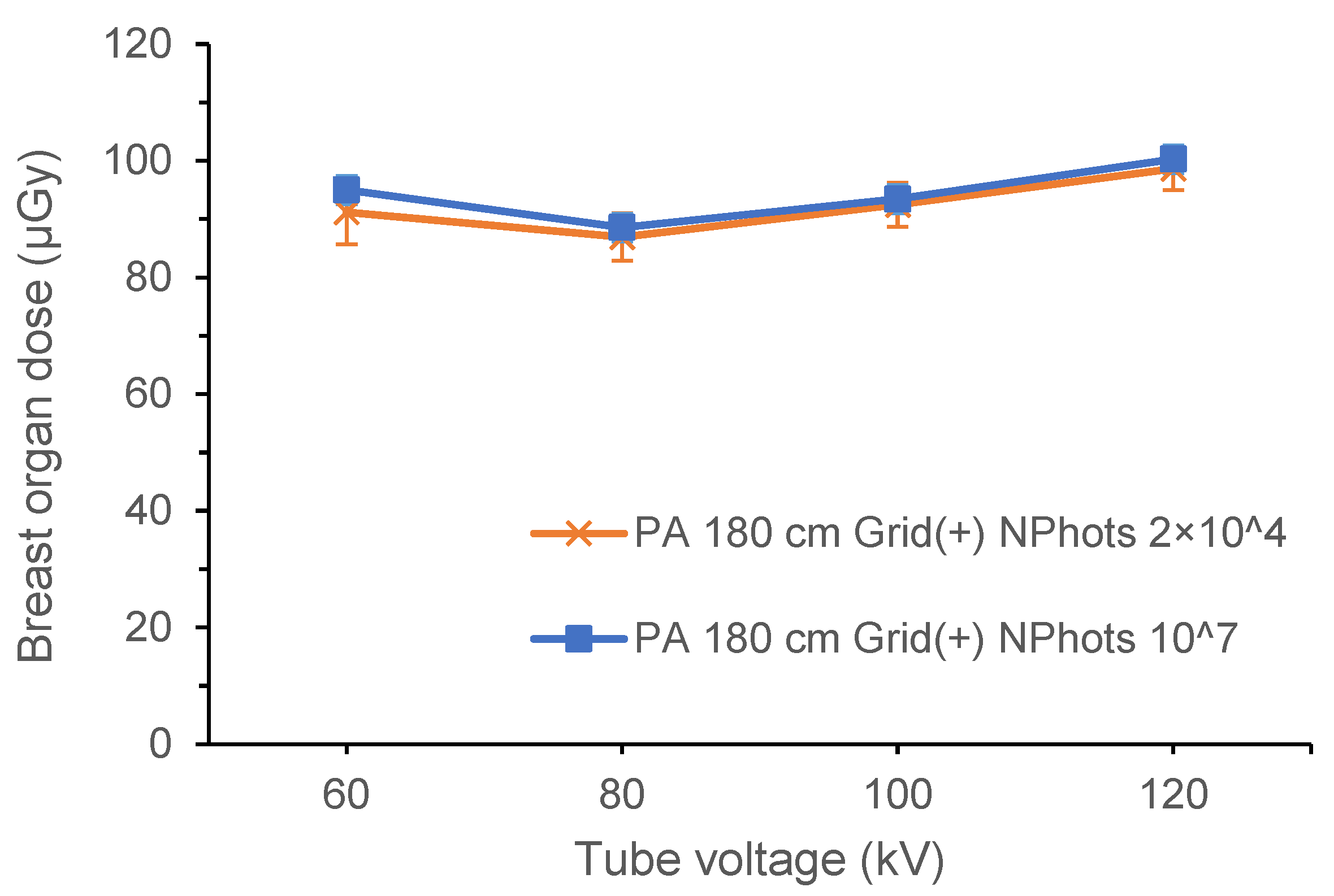
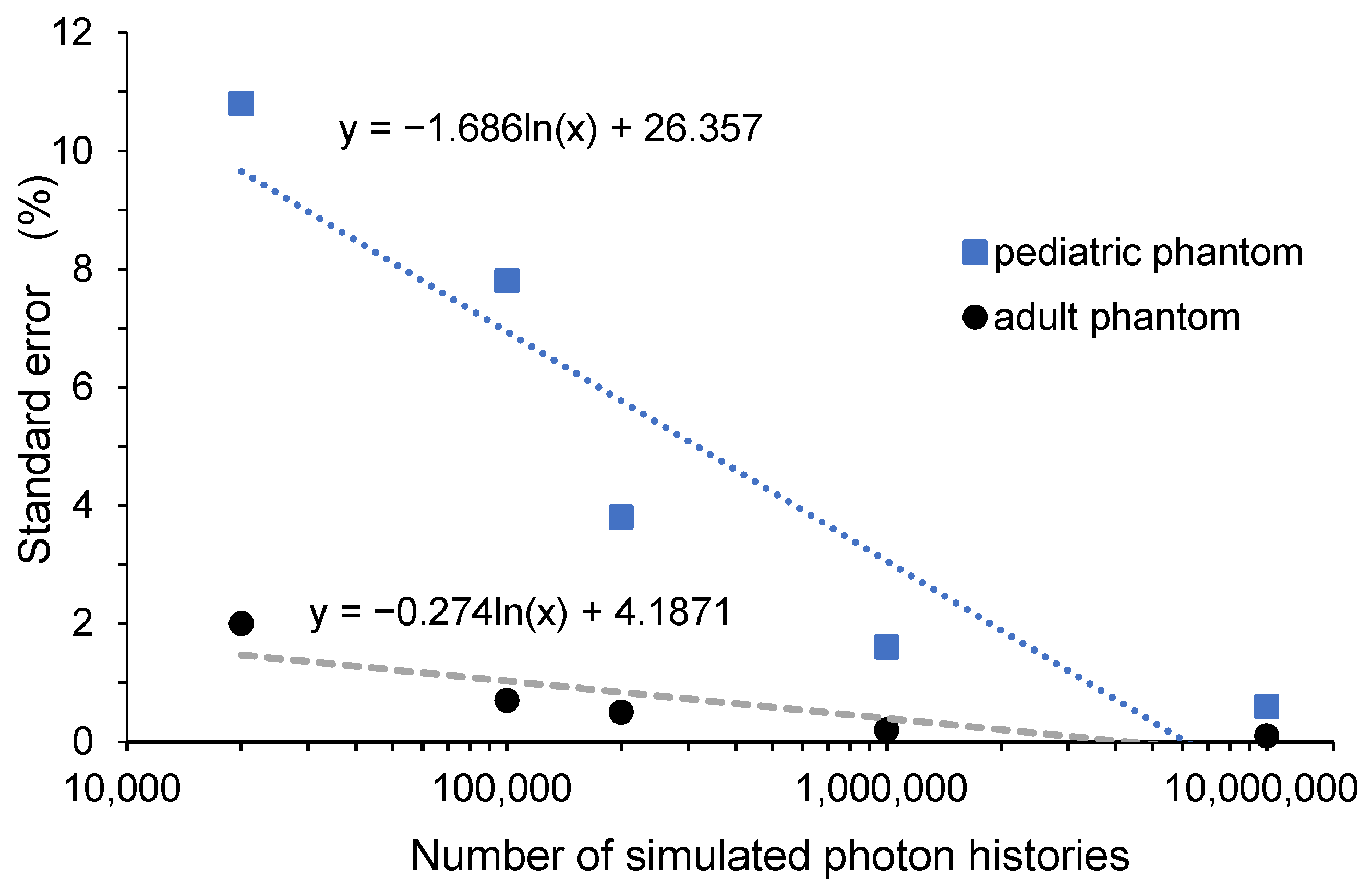
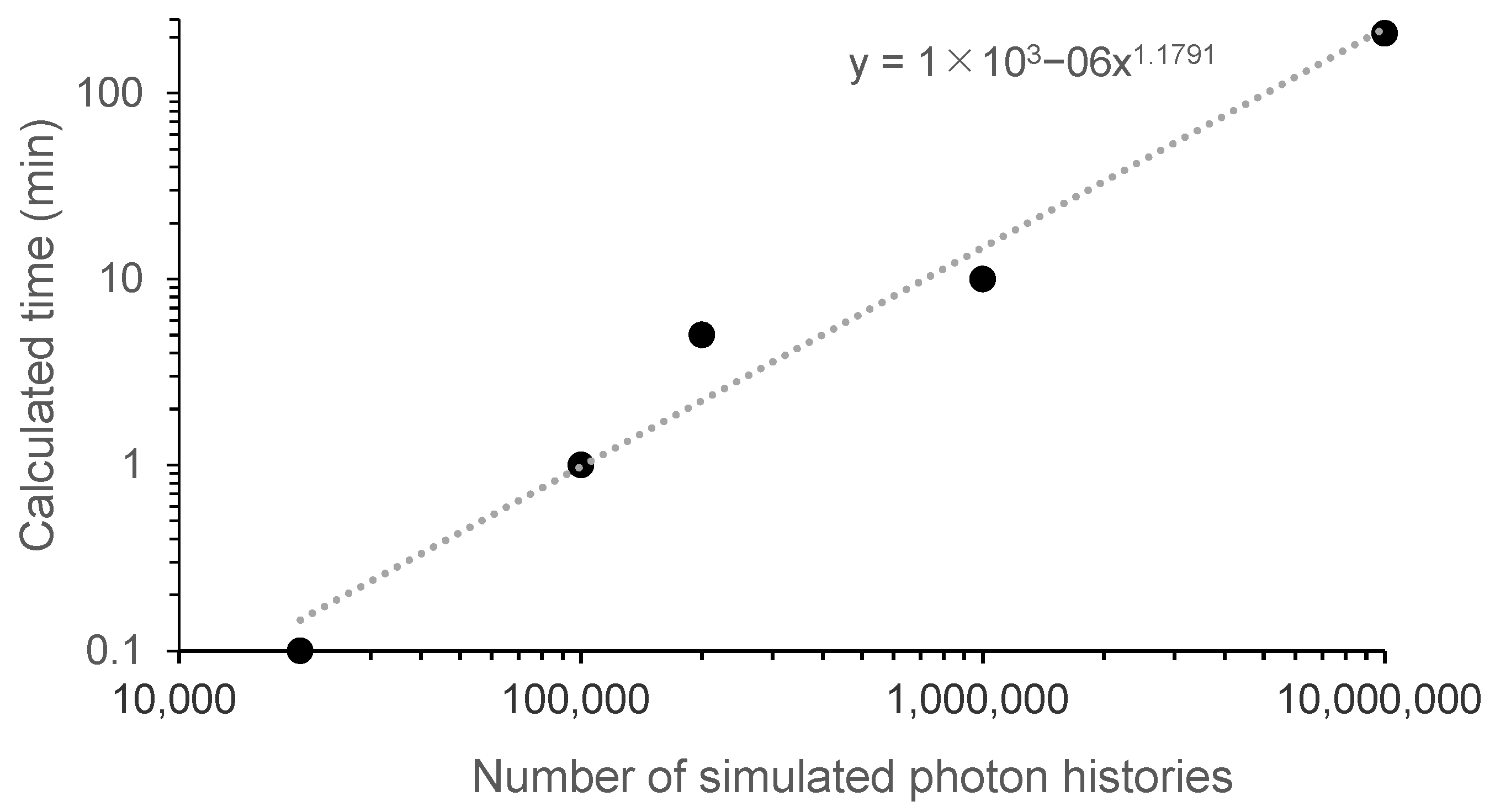
| Projection | FID (cm) | Beam Width × Height at FID (cm2) | Tube Voltage (kV) | mAs | EAK (µGy) | |||||||
|---|---|---|---|---|---|---|---|---|---|---|---|---|
| Child | Adult | Child Grid (−) | Child Grid (+) | Child Grid (−) | Adult Grid (+) | Child Grid (−) | Child Grid (+) | Child Grid (−) | Adult Grid (+) | |||
| AP, PA | 120 | 20 × 47 | 30 × 50 | 60 | 6.4 | 12.6 | 12.8 | 40.0 | 162.4 | 319.7 | 350.5 | 1090.0 |
| 80 | 2.4 | 4.0 | 5.0 | 12.8 | 121.7 | 192.4 | 260.7 | 659.6 | ||||
| 100 | 1.0 | 1.9 | 2.6 | 6.3 | 78.4 | 150.8 | 211.5 | 514.2 | ||||
| 120 | 0.6 | 1.3 | 1.6 | 4.0 | 70.4 | 140.8 | 187.5 | 474.9 | ||||
| AP, PA | 180 | 20 × 55 | 30 × 74 | 60 | 12.6 | 25.2 | 32.0 | 104.0 | 121.6 | 243.1 | 324.1 | 1052.5 |
| 80 | 5.0 | 10.0 | 12.8 | 32.0 | 92.2 | 171.4 | 245.2 | 610.1 | ||||
| 100 | 2.6 | 5.0 | 6.3 | 16.0 | 73.8 | 144.3 | 191.4 | 477.0 | ||||
| 120 | 1.6 | 3.2 | 4.0 | 10.2 | 67.1 | 129.4 | 172.7 | 422.8 | ||||
| Projection | FID (cm) | Beam Width × Height at FID (cm2) | Tube Voltage (kV) | mAs | EAK (µGy) | |||
|---|---|---|---|---|---|---|---|---|
| Child | Adult | Child Grid (+) | Adult Grid (+) | Child Grid (+) | Adult Grid (+) | |||
| AP, PA | 180 | 20 × 55 | 30 × 74 | 80 | 10.0 | 32.0 | 171.4 | 610.1 |
| Projection | Tube Voltage (kV) | FID (cm) | Beam Width (cm, at FID) | Beam Height (cm, at FID) | Grid (−) | Grid (+) | ||||
|---|---|---|---|---|---|---|---|---|---|---|
| mAs | Breasts (µGy) | Error (%) | mAs | Breasts (µGy) | Error (%) | |||||
| AP | 60 | 120 | 20 | 47 | 6.4 | 186.3 | 0.4 | 12.6 | 366.8 | 0.4 |
| AP | 80 | 120 | 20 | 47 | 2.4 | 147.9 | 0.4 | 4.0 | 233.8 | 0.4 |
| AP | 100 | 120 | 20 | 47 | 1.0 | 99.0 | 0.4 | 1.9 | 190.5 | 0.4 |
| AP | 120 | 120 | 20 | 47 | 0.6 | 91.3 | 0.4 | 1.3 | 182.7 | 0.4 |
| AP | 60 | 180 | 20 | 55 | 12.6 | 137.4 | 0.7 | 25.2 | 274.8 | 0.7 |
| AP | 80 | 180 | 20 | 55 | 5.0 | 110.6 | 0.6 | 10.0 | 205.6 | 0.6 |
| AP | 100 | 180 | 20 | 55 | 2.6 | 92.4 | 0.6 | 5.0 | 180.7 | 0.6 |
| AP | 120 | 180 | 20 | 55 | 1.6 | 86.4 | 0.6 | 3.2 | 166.6 | 0.6 |
| PA | 60 | 120 | 20 | 47 | 6.4 | 20.5 | 1.8 | 12.6 | 40.1 | 1.8 |
| PA | 80 | 120 | 20 | 47 | 2.4 | 22.2 | 1.5 | 4.0 | 35.0 | 1.5 |
| PA | 100 | 120 | 20 | 47 | 1.0 | 18.2 | 1.3 | 1.9 | 34.9 | 1.3 |
| PA | 120 | 120 | 20 | 47 | 0.6 | 19.5 | 1.2 | 1.3 | 38.6 | 1.2 |
| PA | 60 | 180 | 20 | 55 | 12.6 | 17.0 | 1.3 | 25.2 | 34.1 | 1.3 |
| PA | 80 | 180 | 20 | 55 | 5.0 | 18.5 | 1.1 | 10.0 | 34.2 | 1.1 |
| PA | 100 | 180 | 20 | 55 | 2.6 | 18.8 | 0.9 | 5.0 | 37.0 | 0.9 |
| PA | 120 | 180 | 20 | 55 | 1.6 | 20.1 | 0.8 | 3.2 | 38.9 | 0.8 |
| Projection | Tube Voltage (kV) | FID (cm) | Beam Width (cm, at FID) | Beam Height (cm, at FID) | Grid (−) | Grid (+) | ||||
|---|---|---|---|---|---|---|---|---|---|---|
| mAs | Breasts (µGy) | Error (%) | mAs | Breasts (µGy) | Error (%) | |||||
| AP | 60 | 120 | 30 | 50 | 12.8 | 321.6 | 0.1 | 40.0 | 1000.0 | 0.1 |
| AP | 80 | 120 | 30 | 50 | 5.0 | 270.3 | 0.1 | 12.8 | 683.9 | 0.1 |
| AP | 100 | 120 | 30 | 50 | 2.6 | 238.0 | 0.1 | 6.3 | 578.7 | 0.1 |
| AP | 120 | 120 | 30 | 50 | 1.6 | 222.8 | 0.1 | 4.0 | 564.3 | 0.1 |
| AP | 60 | 180 | 30 | 74 | 32.0 | 301.3 | 0.1 | 104.0 | 978.6 | 0.1 |
| AP | 80 | 180 | 30 | 74 | 12.8 | 258.2 | 0.1 | 32.0 | 642.6 | 0.1 |
| AP | 100 | 180 | 30 | 74 | 6.3 | 219.1 | 0.1 | 16.0 | 546.1 | 0.1 |
| AP | 120 | 180 | 30 | 74 | 4.0 | 209.0 | 0.1 | 10.2 | 511.6 | 0.1 |
| PA | 60 | 120 | 30 | 50 | 12.8 | 28.7 | 0.3 | 40.0 | 88.9 | 0.3 |
| PA | 80 | 120 | 30 | 50 | 5.0 | 34.1 | 0.2 | 12.8 | 86.4 | 0.2 |
| PA | 100 | 120 | 30 | 50 | 2.6 | 37.1 | 0.1 | 6.3 | 91.2 | 0.1 |
| PA | 120 | 120 | 30 | 50 | 1.6 | 40.0 | 0.1 | 4.0 | 101.4 | 0.1 |
| PA | 60 | 180 | 30 | 74 | 32.0 | 29.3 | 0.3 | 104.0 | 95.0 | 0.3 |
| PA | 80 | 180 | 30 | 74 | 12.8 | 35.6 | 0.2 | 32.0 | 88.6 | 0.2 |
| PA | 100 | 180 | 30 | 74 | 6.3 | 37.5 | 0.2 | 16.0 | 93.4 | 0.2 |
| PA | 120 | 180 | 30 | 74 | 4.0 | 40.8 | 0.2 | 10.2 | 100.3 | 0.2 |
| Average (µGy) | ||||
|---|---|---|---|---|
| Grid (−) AP | Grid (−) PA | Grid (+) AP | Grid (+) PA | |
| Child | 118.9 (86.4–186.3) | 19.4 (17.0–22.2) | 225.2 (166.6–366.8) | 36.6 (34.1–40.1) |
| Adult | 263.2 (222.8–321.6) | 35.4 (28.7–40.8) | 688.2 (511.6–1000.0) | 93.1 (86.4–101.4) |
| Adult/Child | 2.2 (1.7–2.6) | 1.8 (1.7–1.8) | 3.1 (2.7–3.1) | 2.5 (2.5–2.5) |
| Projection | Tube Voltage (kV) | FID (cm) | Beam Width (cm, at FID) | Beam Height (cm, at FID) | Grid (−) | Grid (+) | ||||
|---|---|---|---|---|---|---|---|---|---|---|
| mAs | Breasts (µGy) | Error (%) | mAs | Breasts (µGy) | Error (%) | |||||
| AP | 60 | 120 | 20 | 47 | 6.4 | 192.8 | 12.9 | 12.6 | 380.1 | 12.9 |
| AP | 80 | 120 | 20 | 47 | 2.4 | 147.9 | 11.3 | 4.0 | 233.8 | 11.3 |
| AP | 100 | 120 | 20 | 47 | 1.0 | 99.0 | 10 | 1.9 | 190.4 | 10 |
| AP | 120 | 120 | 20 | 47 | 0.6 | 91.2 | 9.2 | 1.3 | 182.4 | 9.2 |
| AP | 60 | 180 | 20 | 55 | 12.6 | 162.5 | 11.6 | 25.2 | 325.0 | 11.6 |
| AP | 80 | 180 | 20 | 55 | 5.0 | 131.1 | 10.8 | 10.0 | 243.6 | 10.8 |
| AP | 100 | 180 | 20 | 55 | 2.6 | 106.6 | 10.4 | 5.0 | 208.4 | 10.4 |
| AP | 120 | 180 | 20 | 55 | 1.6 | 99.3 | 10.2 | 3.2 | 191.4 | 10.2 |
| PA | 60 | 120 | 20 | 47 | 6.4 | 22.6 | 31.5 | 12.6 | 44.3 | 31.5 |
| PA | 80 | 120 | 20 | 47 | 2.4 | 24.7 | 26 | 4.0 | 38.9 | 26 |
| PA | 100 | 120 | 20 | 47 | 1.0 | 19.1 | 22.7 | 1.9 | 36.6 | 22.7 |
| PA | 120 | 120 | 20 | 47 | 0.6 | 19.9 | 20.3 | 1.3 | 39.4 | 20.3 |
| PA | 60 | 180 | 20 | 55 | 12.6 | 17.7 | 33.6 | 25.2 | 35.4 | 33.6 |
| PA | 80 | 180 | 20 | 55 | 5.0 | 21.4 | 28 | 10.0 | 39.4 | 28 |
| PA | 100 | 180 | 20 | 55 | 2.6 | 21.2 | 25.8 | 5.0 | 41.6 | 25.8 |
| PA | 120 | 180 | 20 | 55 | 1.6 | 22.3 | 24 | 3.2 | 43.2 | 24 |
| Projection | Tube Voltage (kV) | FID (cm) | Beam Width (cm, at FID) | Beam Height (cm, at FID) | Grid (−) | Grid (+) | ||||
|---|---|---|---|---|---|---|---|---|---|---|
| mAs | Breasts (µGy) | Error (%) | mAs | Breasts (µGy) | Error (%) | |||||
| AP | 60 | 120 | 30 | 50 | 12.8 | 325.3 | 1.6 | 40.0 | 1007.7 | 1.6 |
| AP | 80 | 120 | 30 | 50 | 5.0 | 272.6 | 1.3 | 12.8 | 689.8 | 1.3 |
| AP | 100 | 120 | 30 | 50 | 2.6 | 239.8 | 1.1 | 6.3 | 590.1 | 1.1 |
| AP | 120 | 120 | 30 | 50 | 1.6 | 226.5 | 1 | 4.0 | 574.1 | 1 |
| AP | 60 | 180 | 30 | 74 | 32.0 | 312.0 | 2.4 | 104.0 | 1011.5 | 2.4 |
| AP | 80 | 180 | 30 | 74 | 12.8 | 265.5 | 2 | 32.0 | 659.9 | 2 |
| AP | 100 | 180 | 30 | 74 | 6.3 | 224.7 | 1.8 | 16.0 | 559.3 | 1.8 |
| AP | 120 | 180 | 30 | 74 | 4.0 | 212.2 | 1.7 | 10.2 | 521.3 | 1.7 |
| PA | 60 | 120 | 30 | 50 | 12.8 | 28.7 | 5.1 | 40.0 | 88.9 | 5.1 |
| PA | 80 | 120 | 30 | 50 | 5.0 | 34.7 | 4 | 12.8 | 87.9 | 4 |
| PA | 100 | 120 | 30 | 50 | 2.6 | 37.8 | 3.3 | 6.3 | 93.0 | 3.3 |
| PA | 120 | 120 | 30 | 50 | 1.6 | 41.0 | 3 | 4.0 | 103.8 | 3 |
| PA | 60 | 180 | 30 | 74 | 32.0 | 28.1 | 6 | 104.0 | 91.2 | 6 |
| PA | 80 | 180 | 30 | 74 | 12.8 | 35.0 | 4.7 | 32.0 | 86.9 | 4.7 |
| PA | 100 | 180 | 30 | 74 | 6.3 | 37.1 | 4.1 | 16.0 | 92.5 | 4.1 |
| PA | 120 | 180 | 30 | 74 | 4.0 | 40.2 | 3.7 | 10.2 | 98.6 | 3.7 |
| Phantom | Projection | NPhots | Average | MAPE (%) | |
|---|---|---|---|---|---|
| Breasts (µGy) | Error (%) | ||||
| Child | AP | 107 | 206.9 | 0.6 | 16.7 |
| 2 × 104 | 242.1 | 10.8 | |||
| PA | 107 | 36.1 | 1.0 | 10.6 | |
| 2 × 104 | 39.9 | 27.9 | |||
| Adult | AP | 107 | 613.2 | 0.1 | 2.6 |
| 2 × 104 | 629.7 | 2.0 | |||
| PA | 107 | 88.8 | 0.2 | 2.1 | |
| 2 × 104 | 87.0 | 4.6 |
Disclaimer/Publisher’s Note: The statements, opinions and data contained in all publications are solely those of the individual author(s) and contributor(s) and not of MDPI and/or the editor(s). MDPI and/or the editor(s) disclaim responsibility for any injury to people or property resulting from any ideas, methods, instructions or products referred to in the content. |
© 2025 by the authors. Licensee MDPI, Basel, Switzerland. This article is an open access article distributed under the terms and conditions of the Creative Commons Attribution (CC BY) license (https://creativecommons.org/licenses/by/4.0/).
Share and Cite
Nemoto, M.; Chida, K. Breast Organ Dose and Radiation Exposure Reduction in Full-Spine Radiography: A Phantom Model Using PCXMC. Diagnostics 2025, 15, 2787. https://doi.org/10.3390/diagnostics15212787
Nemoto M, Chida K. Breast Organ Dose and Radiation Exposure Reduction in Full-Spine Radiography: A Phantom Model Using PCXMC. Diagnostics. 2025; 15(21):2787. https://doi.org/10.3390/diagnostics15212787
Chicago/Turabian StyleNemoto, Manami, and Koichi Chida. 2025. "Breast Organ Dose and Radiation Exposure Reduction in Full-Spine Radiography: A Phantom Model Using PCXMC" Diagnostics 15, no. 21: 2787. https://doi.org/10.3390/diagnostics15212787
APA StyleNemoto, M., & Chida, K. (2025). Breast Organ Dose and Radiation Exposure Reduction in Full-Spine Radiography: A Phantom Model Using PCXMC. Diagnostics, 15(21), 2787. https://doi.org/10.3390/diagnostics15212787






